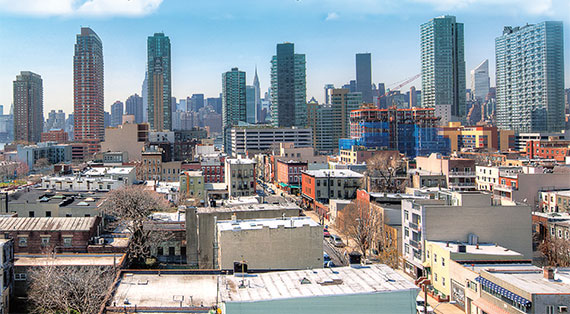
The residential revolution is well underway in Long Island City, as multiple condo and rental towers sprout where crumbling warehouses and manufacturing holdouts once stood.
But while residents filling those thousands of new apartments may be enjoying luxury amenities in their buildings and neighborhood features like the new dog run at Hunter’s Point South, the surrounding area is still disappointingly desolate when it comes to stores. And while retail typically follows residential in a gentrifying area, in Long Island City, there are few signs of an accompanying retail revolution in the works.
In the past 10 years, roughly 9,000 new living units debuted, according to data from Long Island City–based brokerage Modern Spaces. By the end of 2017, at least 14,413 additional units will hit the market, from developers like Property Markets Group, World Wide Group and Rockrose Development. This wave is rushing into a neighborhood that until now housed a modest population, pegged at just under 21,000 in the 2010 Census.
The question is, where are the stores to serve the people who fill those towers? Retail “is the biggest need, and it doesn’t take a real estate expert to see that there’s so much development happening, but we’re still behind on the retail,” said Dana Frankel, the director of economic development, planning and BID services for the Long Island City Partnership.
“There are still a lot of retailers that are like, ‘Long Island City? Where the hell is that?’ ” said Matthew Baron, president of Simon Baron Development, which has completed one Long Island City rental building and has two properties in the works.

Matthew Baron
Bullish brokers and developers point to a handful of big leases inked over the past decade. In 2008, Rockrose brought upscale grocer Foodcellar & Co. to the lower levels of its 31-story, 394-unit residential building at 4705 Center Boulevard near the waterfront, where one-bedrooms rent for $3,000 to $3,500 a month. The only drugstore chain in the area, a Duane Reade, opened around the time Foodcellar did, in the base of the same building. Foodcellar will soon open its second location, in Court Square, in another Rockrose building, Linc LIC.
But these leases are no longer new, and the lag between them and the arrival of other chains has been surprising, and particularly stark in certain pockets.
Retail brokers divide Long Island City into several distinct areas. The first is the waterfront, where many glassy towers developed by Rockrose, TF Cornerstone and others are already occupied, and where residents will start moving into Related Companies’ Hunter’s Point South this spring. The neighborhood features ground-floor retail in the base of the new Center Boulevard buildings, with spaces ranging from 1,000 to 8,000 square feet. The nearby commercial strip of Vernon Boulevard is lined with smaller boutique shops, many of which are only nine or 10 feet wide, in older walk-up buildings.
This is the portion of Long Island City with the healthiest retail scene, including steady foot traffic on weekends and an array of dining options. “That already feels more like a neighborhood more than any other part of Long Island City does,” said Brad Schwarz, a principal with commercial brokerage Lee & Associates. Center Boulevard retail is close to fully occupied, with Vernon Boulevard not far behind, according to Dean Rosenzweig, a vice president at CBRE.
Further inland, however, things are bleaker. Court Square, where the Citigroup building stands, and Queens Plaza, which is home to JetBlue and Silvercup Studios, each constitute separate retail markets where office workers have scavenged for lunch options for years and where the residents of a bevy of new towers could face a similar fate in search of necessities, if things don’t pick up.
David Brause, president of Brause Realty and chair of the Long Island City Business Improvement District, said that there is a definite need for more food options for office workers in these areas, as well as nice brunch spots for residents. The waterfront and Vernon Boulevard has “a phenomenal collection of restaurants. We’d love to see that expand north into Court Square and Queens Plaza,” he said.
Many sources lamented the lack of a major drugstore or grocery store to anchor the area, though the opening of the Court Square Foodcellar will provide some relief. Some say that the number of residents in those areas doesn’t yet justify the investment for retailers. “With all the development surrounding Jackson Avenue and Queens Plaza, those services have yet to come, partially because buildings are going up or are planned. They’re just not here yet, so people are questioning the overall viability of those parts of Long Island City,” said CBRE broker Jeremy Scholder.
CBRE’s Rosenzweig spoke of a “herd mentality” that is just starting to ease. In the last few years, clients have told him, “Look at Brooklyn, make sure Williamsburg is on the list,” he said. “When we suggest Long Island City, they scratch their heads. It’s almost an afterthought.”
Recently, however, national chains that Rosenzweig brought to the area have expressed more interest, though they are hesitant to sign because sales projections are low for the first few years.
Eric Benaim, president of brokerage Modern Spaces, said that he has heard rumors of chains like Starbucks, Whole Foods, Tim Hortons, and Jamba Juice looking in the area, but so far none have inked leases.

Eric Benaim
Commercial rents in the neighborhood have a wide range, from about $45 to $75 per square foot, according to multiple sources, with the priciest spaces located on Vernon Boulevard, and the most affordable in the Queens Plaza area. By comparison, Williamsburg retail currently ranges from about $100 to $300 per square foot, while Astoria rents are closer to Long Island City’s, with the most desirable locations reaching $100 per foot.
“This could be the bargain of the decade for forward-thinking retailers,” said Faith Hope Consolo, chair of Douglas Elliman’s retail group.
Schwarz and other brokers said their main selling tool for Long Island City is a map of all the residential development in the works. “Here’s the rent that you can get today. That rent is going to be double or triple in four or five years,” he tells clients. “As the residential population grows, you knock it out of the park.”
With much of the residential development designed to attract families, one notable hole right now is a lack of large spaces that could house supermarkets or big-box retailers. But several upcoming developments include sizable retail spaces. The two towers being built by G&M Realty’s Jerry and David Wolkoff on the former 5Pointz site, for example, will include 50,000 square feet of retail space. And Simon Baron Development’s residential project at 29-26 Northern Boulevard will have almost 20,000 square feet of retail, while 3030 Northern Boulevard, an office and retail property being developed by Alma Realty, will have 138,000 square feet over three floors.
Brokers said the demographics of the newcomers are even more promising for retailers than the head count. Benaim said households settling in Long Island City typically have annual incomes of $150,000 or above, with $500,000 not uncommon. A large portion of the influx works in the financial industry, and many are families with children.
As retailers take note of those demographics, “it’ll give them the increased confidence in locating here,” said Scholder. “As the next census comes about in five years, there’s going to be a lot of change in the area.”
